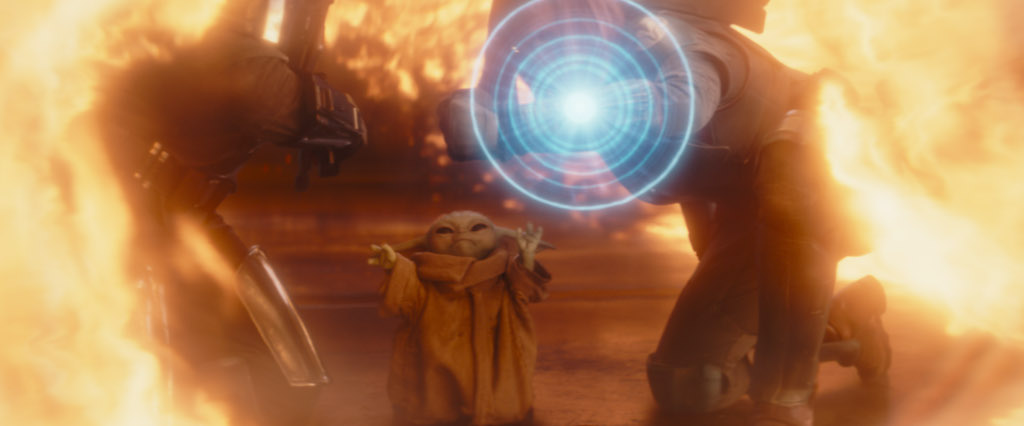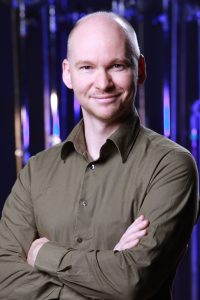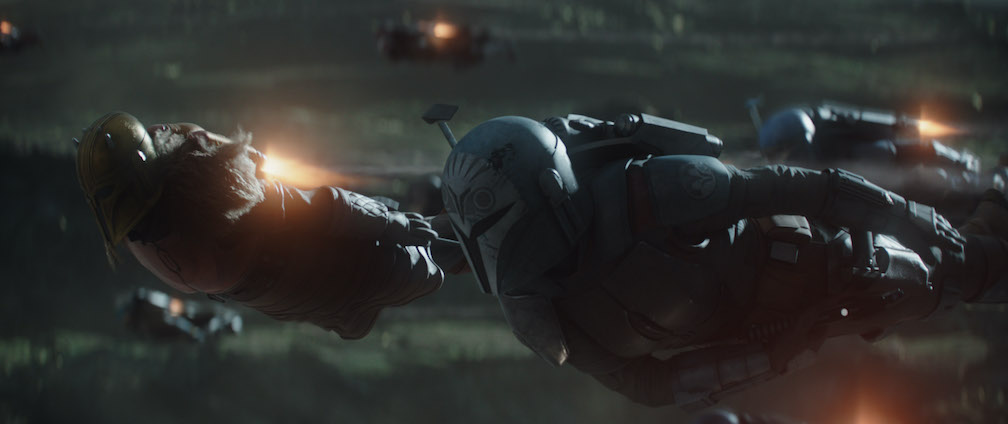
In the third season of Disney’s hit series The Mandalorian, Din Djarin (Pedro Pascal) joins forces with Bo-Katan (Katee Sackhoff) to revive their home planet of Mandalore, left in ruins after battle. They encounter pirates, sabotaged droids, and the makings of a clone army on a journey that finds Djarin adopting Grogu, the young Yoda.
Visual effects supervisor Grady Cofer worked with hundreds of artists and technicians to deliver the series’ often astonishing effects. Along with colleagues Abbigail Keller, Paul Kavanagh, Cameron Neilson, Hal T. Hickel, J. Alan Scott, Victor Schutz, Bobo Skipper, and Scott R. Fisher, Cofer was nominated for a Primetime Emmy in the category Outstanding Special Visual Effects in a Season or a Movie.
Cofer has worked at Industrial Light & Magic for over a decade. His films include Battleship, Noah, and Ready Player One, for which he received an Oscar nomination. He spoke with Below the Line by phone from his office at ILM.
Below the Line: How big is your team for this series?
Grady Cofer: This season was pretty epic. Our crew spans several continents, and numbered in the hundreds. Full disclosure, I was working with multiple vendors: Industrial Light & Magic, of course, but also Hybride, Important Looking Pirates, Image Engine, Ghost, and others.

Below the Line: How soon did you start working on this season?
Grady Cofer: Everything starts with the story, with Jon Favreau working with Dave Filoni and Noah Kloor. As soon as the scripts start coming in, the production designers Doug Chiang and Andrew L. Jones start making these beautiful concept pieces for Jon’s ideas; that art can inspire Jon to go into new directions with the stories.
The Mandalorian is a big virtual production, so the VFX team is on calls and meetings from the very beginning. We have to figure out which environments, which scenes, we might want to execute using StageCraft on the LED stages. We’ve learned a lot over the years about what plays well on screen, so we pinpointed scenes for the LED walls.
You have to start generating that content early on. I’d say we were in pre-production for the greater part of a year.
Below the Line: So you’re pretty advanced into season four by now?
Grady Cofer: Yeah, it’s all happening.
Below the Line: What kind of advances in software or technology were you able to employ this season?
Grady Cofer: I think we had some very clever applications of both StageCraft and Unreal technology this season. One of my favorite episodes this season was the third one, directed by Isaac Chung. It’s very Hitchcockian, every single shot carefully planned out.
One of my favorite environments is Pershing’s (Omid Abtahi) office. Andrew [Jones] built I think six actual desks, which we extended off into the distance. In addition to that, we had characters and creatures walking around in the background, like a droid dropping off papers at desks. All that was playing live on the wall in Unreal. It was a fun use of real-time technology that I feel was pretty invisible to the audience when it was shot through the camera.
Below the Line: So Pershing can act at his desk and behind him are creatures he can respond to?
Grady Cofer: He’s interacting with real actors on the set, and we had a real droid sliding by in the foreground. All the foreground action takes place inside the volume on the set floor. But behind him it’s virtual. What tricks the eye is the repetition of forms, the foreground desks and cubicles repeated into the distance, with very nice lighting.
But we needed to populate that space, and that’s something we haven’t tried that frequently before. It’s definitely something we want to push. So the virtual people at virtual desks are triggerable inside of Unreal. Just like you would cue an actor to hit his or her marks, you’re doing the same thing virtually.
You can adjust a lot of things, both in Unreal and in ILM’s StageCraft Helios software. You can rebake the lighting pretty quickly. If you show up on set and you realize you want the angle of the sun coming through the window a bit shallower, you just go to the computer and move the sun. You see the change very close to live.
Below the Line: That must be a great asset for creativity, to be able to make changes quickly.
Grady Cofer: Absolutely. And it’s done through a very friendly interface. We actually have an iPad next to the director or DP. If they want to change lighting or move an object in space, you can accommodate a lot of those changes live.

Below the Line: How many different layers and types of effects can be going on at once? In the second episode, when Djarin goes into the mines of Mandalore, you seem to have practical effects, animation, and virtual effects in shots.
Grady Cofer: It’s the combination of those things that takes the work to a higher level. We pushed technologies in our world-building this season, and I think you really see that on Mandalore. We knew the audience was really anticipating going there, and that we had to get everything right. We had a massive storm system shrouding the planet, the ruins, the mines, the Living Waters. These are things fans have really been waiting for.
Every step of the way had to be carefully designed and executed. Doug Chiang’s team deserves a lot of credit for the beautiful art concepts they developed. I think the VFX team did a very nice job utilizing those environments and making them feel like they have a history, that they’re lived in.
That connects to the overall visual effects philosophy on the show: aim for the highest level of computer graphics and animation, but balance them with more traditional techniques. Practical creature effects, animatronics, model miniatures — all of those old school tricks that I grew up. Inject a bit of analog into these digital worlds.
That’s exactly what we aimed to do with Mandalore. Many aspects of it are digital. As Mando and Grogu are walking through the mines, they’re on a beautiful practical set with a virtual set on the walls. But even that virtual set has practical aspects to it.
Jon wanted Din’s descent to be psychological as well as physical. He wanted it to have a nightmarish quality. We actually asked Phil Tippett, one of the legends of the VFX world, to help out. Phil has this way of imbuing his designs with a darker side. If you’ve seen Mad God, you’ll know what I’m talking about.
He and his team built miniature sets of the mines, and dressed them with all of these details, like handmade totems. You see what look like roots or entrails coming down into the sewers. Jon Favreau loved it.
We scanned all of that and incorporated handcrafted details into our virtual space. To me, when you can combine the latest technology with those old school techniques, that’s what takes the work to a new level.
Below the Line: How did you pull off the Living Waters sequence?
Grady Cofer: We shot that in volumes. We had a practical set, we had imagery using StageCraft on the volume walls, and we initially shot it dry for wet. No water at first. We shot the scene, and then we built a black-bottom pool, like a tank. That was for when Mando would walk down the stairs and interact with the water.
When he gets sucked underneath, and Bo has this epic descent to rescue him, all of that was virtual, using computer graphics.
First used motion capture to film the stunt team pretending to swim underwater on rigs and counterweights. Rachel Morrison, who directed that episode, could direct them and shoot them using a kind of virtual camera. So although there was a lot of animation that we did after the fact, it was grounded in a bit of reality, a foundation of real body motion.
Then everything that was underwater was simulated and rendered as water. We used deep-sea diving underwater photography as a reference. The big trick was when Bo reaches the bottom and finds Mando. As she’s picking him up, it stirs up silt. It’s a complex interaction of water and silt in the simulation.
We had this great design for the mythosaur from Doug’s team which we modeled in 3D. When we were creating the underwater environment, we incorporated aspects of the mythosaur into the walls. When we cut to Bo’s POV, you’re not really sure if you’re seeing a wall, or seeing rock, or all of a sudden now maybe you’re seeing scales. Then you see an eye that blinks. We wanted it to feel like a dream, or a vision.
Below the Line: Working with different directors, is it more or less the same process?
Grady Cofer: I love it. Every director brings his or her aesthetic. Rick directed multiple episodes and is a key part of the show. Chung is so thoughtful in his storytelling. I had so much fun with Carl Weathers, especially developing the pre-vis. Bryce Dallas Howard, a veteran of the show, is super creative. Peter Ramsey brought his great animation chops. And Rachel, who is a great DP in her own right, had a strong vision for the work.
Personally, it makes the experience of the show so rewarding. I enjoy working with creative artists. I want to help them tell their stories. To me, it’s all about people and collaboration. Of course including Jon and Dave Filoni.
Even though executing the work on the show was a massive undertaking for me, it was a pleasure from beginning to end because of that collaboration. Honestly, I think that’s the key to the show’s success.
The Mandalorian season three is now available to stream on Disney+.





